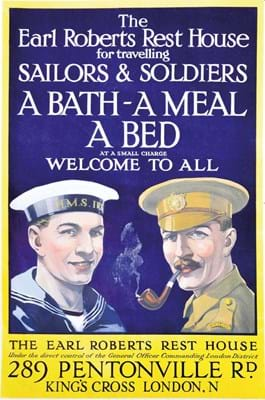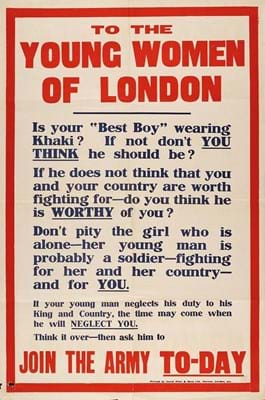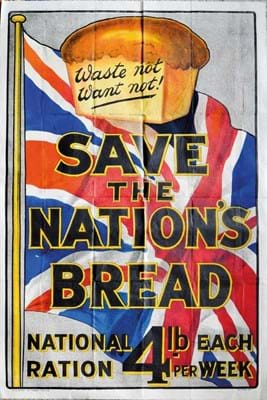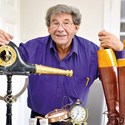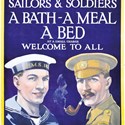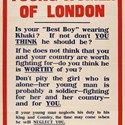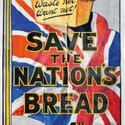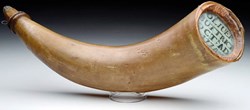Once you have got the collecting bug it is very hard to stop, as Collins recognises well.
Known best as a ‘Mr Gadget’ who amassed a large selection of the ‘weird and wonderful’ such as a clockwork teasmade and an adjustable skirt lifter, Collins is showing a different side to his interests at the London Art Antiques & Interiors Fair at the ExCeL venue in east London from Friday to Sunday, January 12-14.
He has recruited extensive groups of British propaganda posters from both world wars to his collection, and is holding an exhibition and talk at the fair of Great War examples to mark the centenary of the end of that conflict.
Portobello poster purchase
The Collins poster collecting bug is very much in evidence decades after it began: as ATG calls for a chat, he describes his latest buy.
“I source them from everywhere, including fairs, dealers and auctions, over the past 40 years,” he says.
Collins acquired a poster only last week in Portobello Road. “It was stuck away in the back of a guy’s shop and wasn’t in a wonderful state. But I’ve never seen this particular poster before and thought ‘I’ve got to have a go at this’.
“It was in German and English from 1918, and I don’t know where it would have been used. The poster tells the local population that if they throw something at a soldier, it might result in the death penalty.
“I can only think it was the Rhineland, which was the only part occupied after the war. In fact, I’m just going off to the National Army Museum to see if they have any knowledge of that.”
Social history
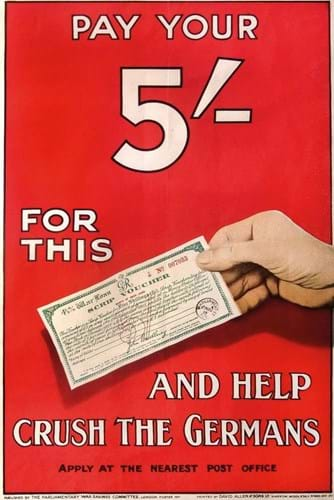
More examples from Maurice Collins’ First World War posters collection which will be on display at the January London Art Antiques & Interiors Fair.
Collins has about 50 examples of the 150-plus First World War British recruitment posters designed. Far from being separate to his gadget collection, he sees them as linking in with the same theme of social history. This is clearly a fascination of his.
He did his national service in the RAF, but the posters also fit in with his work background.
“I was a printer in my early days so my interest in print has always been there,” says Collins, who lives in north London.
He started collecting Second World War posters by Abram Games (1914-1996), the British graphic artist and illustrator who was the sole official poster designer to the British War Office. Games also designed for the 1948 London Olympics and the 1951 Festival of Britain. “He designed the poster called ‘blonde bombshell’ [‘Join the ATS’], the one Parliament asked to be taken down because she was too pretty – that had always intrigued me,” Collins says.
The First World War posters were significant in an era without instant communication tools such as social media. “I have always been fascinated by how posters work and how, during the First World War, the medium of posters was one of the only ways to reach the population and entice them to join up, sadly, to go to the trenches. I always thought that was an impressive effect of the printed word.”
He is intrigued by the way posters reflected the conflict as the British experience changed over the years, from exhorting volunteers in the early stages of the war in 1914 through to the pals battalions and conscription in 1916.
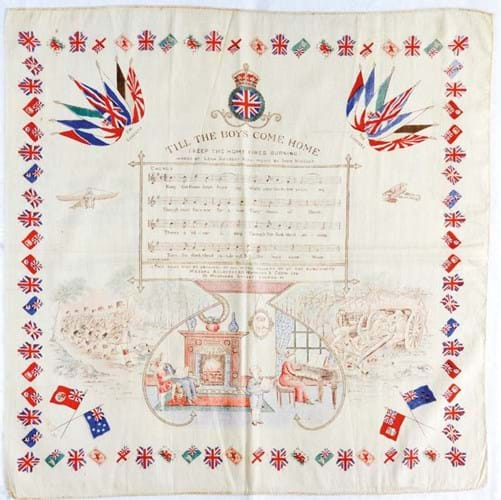
Not every item Maurice Collins will have on display is a poster – this serviette details the music to and words of a song titled Till the Boys Come Home (Keep the Home Fires Burning).
Home comforts (or lack of)
This particular collector is not just interested in posters to do with the armed forces, however. When talking to Collins, it becomes obvious he is equally fascinated by the home front, particularly the posters encouraging women to take a man’s place in the factory, or for fundraising appeals.
Other designs on display focus on newer forms of warfare. “Two posters on show that are quite unusual are for the Royal Flying Corps on training pilots how to sort out bombing and fighting in biplanes,” Collins says.
However, asked to pick out a poster that he finds particularly striking, he plumps for one that is nothing to do with exhortations to fight, but more about the aftermath.
“There is one I really like which is after the war, for The Earl Roberts Rest House for travelling sailors and soldiers – offering a bath, a meal and a bed welcome to all – at 289 Pentonville Road. It has a beautiful picture of a soldier smoking a pipe next to a sailor.”
Over 40 years of collecting, it is hard for Collins to say where specific posters came from, but he mentions as happy hunting grounds Portobello Road, auction houses such as poster specialist Onslows and dealers – many of whom have come to him with items.
“I even bought an amazing First World War poster from a poster shop in New York, The Ross Art Group [the long frieze design pictured below].”
Hundred-year era
The world wars fit into Collins’ main overall era of interest as a collector, from the Great Exhibition in 1851 to the Festival of Britain in 1951. Interest in such occasions are yet another nod to his background – his role now as an exhibition organiser.
While last year he attended the Antiques for Everyone summer fair in Birmingham with a gadgets focus, in 2018 his wartime posters will go on show at museums, mainly in Scotland after. He has a book coming out, Bizarre & Outlandish Gadgets & Doohickeys: Used in Everyday Life 1851- 1951 (available on Amazon). Proceeds from all such activities go to learning disabilities charities. “I also lend gadgets out to museums and TV shows, mostly quiz shows, earning a few bob for the charity,” he adds.
Collins has a daughter with learning disabilities and a younger son. “When they were growing up I realised I was putting all my attention on my daughter and not my son, so I asked him what he would like to do. He told me he wanted to ‘go digging on old rubbish dumps’.
“So that started me collecting,” Collins recalls. “My son’s interest faded away very rapidly but I was the one who got the bug and started collecting and getting interested in social history.”



